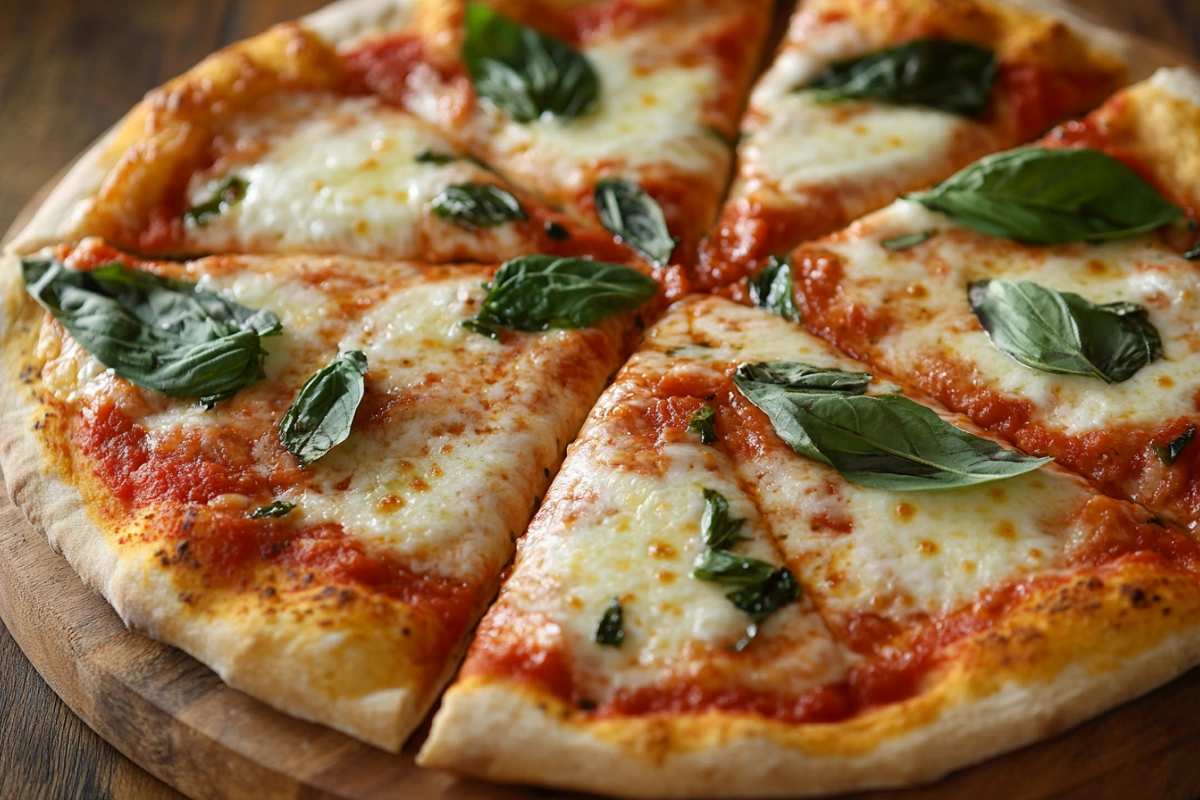If you’re a fan of pizza, you might have heard of buffalo mozzarella. This creamy, rich cheese hails from Italy and is a delightful topping for any pizza. But what exactly is buffalo mozzarella, and why should you consider using it on your next pizza night? In this article, we’ll explore the characteristics of buffalo mozzarella, its uses on pizza, the benefits and potential drawbacks, and tips for preparing it. Whether you’re a culinary novice or a seasoned chef, understanding how to incorporate buffalo mozzarella into your pizza will elevate your dining experience. Let’s dive in!
Part 1: What is Buffalo Mozzarella?
Definition
So, what is buffalo mozzarella? Simply put, it’s a type of cheese made from the milk of water buffaloes. This creamy cheese is renowned for its soft texture and unique flavor profile, which sets it apart from its cow’s milk counterpart. In Italy, where it originated, buffalo mozzarella is a staple in many traditional dishes, especially pizza. Its rich, buttery taste adds a depth of flavor that can truly transform any meal.
Origin and Production Process
Buffalo mozzarella has a fascinating history. It originated in the Campania region of Italy, particularly in areas like Naples and Caserta. The cheese-making process is quite unique. It begins with fresh buffalo milk, which is then heated and combined with rennet to curdle it. After forming curds, the cheese is kneaded and stretched in hot water—a process known as pasta filata. This gives buffalo mozzarella its signature stretchy texture.
The production of buffalo mozzarella also adheres to strict quality standards. In fact, authentic buffalo mozzarella is protected by the European Union’s Protected Designation of Origin (PDO) status, ensuring that only cheese produced in certain regions of Italy can carry the name. This means that when you purchase buffalo mozzarella, you’re getting a product with a rich tradition and high-quality standards.
Differences from Cow’s Milk Mozzarella
While both buffalo and cow’s milk mozzarella share similarities, they also have notable differences. Buffalo mozzarella tends to have a higher fat content, making it creamier and richer. In contrast, cow’s milk mozzarella is milder and often has a firmer texture. The flavor of buffalo mozzarella is more pronounced, with a slight tang that can enhance the overall taste of your dishes.
In summary, buffalo mozzarella isn’t just any cheese; it’s a luxurious ingredient with a unique production process and a rich flavor profile. This sets the stage for why it’s such an excellent choice for pizza. As we explore more about its characteristics and uses, you’ll see why this cheese is often celebrated in culinary circles.

Part 2: Benefits of Using Buffalo Mozzarella on Pizza
1. Rich Flavor Profile
One of the standout reasons to use mozzarella on your pizza is its rich, creamy flavor. Unlike standard cow’s milk mozzarella, buffalo mozzarella has a more intense, slightly tangy taste that enhances the overall flavor of the dish. This quality makes it an excellent choice for traditional Italian pizzas, especially when paired with fresh tomatoes, basil, and a drizzle of olive oil.
2. Creamy Texture
The texture of buffalo mozzarella is another significant advantage. When baked, it melts beautifully, creating a creamy, luscious layer that elevates your pizza experience. This cheese stretches wonderfully, making every bite satisfying. The combination of its smooth texture and rich flavor creates a delightful mouthfeel that keeps you coming back for more.
3. Nutritional Benefits
Buffalo mozzarella is not only delicious but also nutritious. It typically contains higher fat and protein content than cow’s milk mozzarella, contributing to its creamy texture. The protein in mozzarella can help you feel fuller for longer, making it a satisfying choice for pizza lovers. Additionally, buffalo milk is often easier to digest for some people, which may be beneficial for those with lactose sensitivities.
4. Versatility
Buffalo mozzarella is incredibly versatile in culinary applications. While it’s famously used on pizza, it can also shine in salads, pasta dishes, or even as a standalone snack. Its flavor pairs well with a variety of ingredients, including fruits, nuts, and different types of herbs.
Moreover, buffalo mozzarella can be used fresh or aged, making it adaptable for various recipes. Fresh mozzarella works wonderfully on Margherita pizzas, while aged varieties can add depth to other dishes.
5. Authentic Italian Experience
Using buffalo mozzarella can transport you to Italy with just one bite! It’s an essential ingredient in traditional Neapolitan pizza. When you choose this cheese, you’re embracing authenticity and paying homage to Italian culinary traditions.
This commitment to authenticity can enhance your cooking, making your pizza-making process feel more like a gourmet experience. It’s also a great conversation starter when sharing a meal with friends or family, as many people might not be familiar with the differences between mozzarella and other types of cheese.
Part 3: How to Use Buffalo Mozzarella on Pizza
1. Choosing the Right Buffalo Mozzarella
When it comes to selecting mozzarella for your pizza, quality matters! Look for brands that source their mozzarella from Italy, as authentic Italian buffalo mozzarella is made from the milk of water buffalo raised in specific regions, particularly Campania. This ensures you’re getting the best flavor and texture. Fresh mozzarella is typically sold in water or brine, while aged varieties are firmer and more concentrated in flavor.
2. Preparing the Pizza Dough
To create a delicious pizza, start with a solid dough base. You can make your dough from scratch using flour, yeast, water, salt, and olive oil, or you can purchase pre-made dough from a store. Here’s a quick guide to making your pizza dough:
- Combine Ingredients: In a mixing bowl, combine 2 cups of flour, 1 packet of yeast, 1 teaspoon of salt, and 3/4 cup of warm water. Mix until a dough forms.
- Knead the Dough: On a floured surface, knead the dough for about 5–7 minutes until it becomes smooth and elastic.
- Let it Rise: Place the dough in a greased bowl, cover it with a cloth, and let it rise for about an hour in a warm place until it doubles in size.
- Shape the Dough: Once risen, punch down the dough and roll it out to your desired thickness. You can make it thin and crispy or thicker and chewier, depending on your preference.
3. Assembling the Pizza
Now that your dough is ready, it’s time to assemble your pizza:
- Preheat the Oven: Preheat your oven to a high temperature, ideally around 475°F (245°C). If you have a pizza stone, place it in the oven while it heats up.
- Add Sauce: Spread a thin layer of tomato sauce over the rolled-out dough. For an extra touch, consider using a homemade sauce made from fresh tomatoes, garlic, and basil.
- Layer the Cheese: Tear or slice your fresh mozzarella into bite-sized pieces. Distribute the cheese evenly over the sauce. The more, the merrier, right?
- Add Toppings: Feel free to add additional toppings such as fresh basil, sliced tomatoes, or a sprinkle of grated Parmesan. Just be careful not to overload your pizza, as this can make it soggy.
4. Baking the Pizza
- Bake: Carefully transfer your assembled pizza onto the preheated pizza stone or a baking sheet. Bake for 10–15 minutes, or until the crust is golden and the cheese is bubbling.
- Finishing Touches: Once out of the oven, drizzle with a little extra virgin olive oil and sprinkle with sea salt for added flavor.
5. Enjoying Your Buffalo Mozzarella Pizza
Slice up your pizza and serve it hot! The rich, creamy mozzarella will be perfectly melted, adding a decadent touch to each bite. Pair it with a simple arugula salad or some roasted vegetables for a complete meal.

Part 4: Common Mistakes to Avoid When Using Buffalo Mozzarella on Pizza
1. Overloading with Toppings
One of the biggest pitfalls when making pizza is overloading it with toppings. While it’s tempting to pile on everything from meats to vegetables, doing so can lead to a soggy crust. The delicate texture of mozzarella is best complemented by a balanced selection of toppings. To maintain that perfect balance, aim for just a few high-quality ingredients that will enhance the cheese rather than overpower it.
2. Not Draining the Cheese
Buffalo mozzarella comes packed in water or brine to keep it fresh. However, using it straight from the container without draining can make your pizza watery. To avoid this, gently pat the mozzarella dry with a paper towel or let it sit in a colander for a few minutes before using. This step helps to preserve the crust’s integrity and ensures a beautifully cooked pizza.
3. Baking at the Wrong Temperature
Another common mistake is not baking your pizza at a high enough temperature. For the best results, your oven should be preheated to around 475°F (245°C) or higher. A hotter oven will yield a crispy crust while allowing the mozzarella to melt perfectly. If your oven isn’t hot enough, your pizza may end up soggy or undercooked.
4. Skipping the Pre-Baking Step
If you’re using a particularly moist topping, it might be beneficial to pre-bake your crust for a few minutes before adding the sauce and cheese. This technique helps to set the dough and can prevent sogginess. It’s a simple step that can dramatically improve your pizza’s texture.
5. Forgetting to Add Flavor Enhancements
Buffalo mozzarella has a rich, creamy flavor, but it can be elevated even further with the right enhancements. Don’t forget to season your sauce with salt, pepper, and fresh herbs. A drizzle of high-quality extra virgin olive oil just before serving can also enhance the overall taste. These small touches can make a big difference!
Part 5: How to Store Buffalo Mozzarella for Optimal Freshness
1. Understanding Storage Needs
Buffalo mozzarella is a fresh cheese known for its creamy texture and rich flavor. To maintain its quality, it’s essential to store it correctly. If you’ve got leftover mozzarella after making pizza, follow these storage tips to ensure it stays fresh and delicious.
2. Keeping it in Water or Brine
When storing leftover mozzarella, the first step is to keep it submerged in its original liquid. This could be either water or brine, depending on how it was packaged. The liquid helps to maintain moisture and prevent the cheese from drying out. If the cheese has been opened, make sure it’s fully covered to protect it from air exposure, which can lead to spoilage.
3. Refrigeration is Key
Buffalo mozzarella should always be stored in the refrigerator. The ideal temperature is between 35°F and 40°F (1°C and 4°C). If you have a cheese drawer, that’s often the best spot to keep it, as it tends to maintain a consistent temperature. Avoid leaving it out at room temperature for extended periods, as this can spoil the cheese quickly.
4. Using Airtight Containers
If you’ve drained the cheese and want to store it without the brine, consider using an airtight container. Add a small amount of water to the bottom of the container, just enough to keep the mozzarella moist. This method can also prolong the freshness of the cheese while reducing its exposure to air.
5. Freezing for Longer Storage
If you can’t use your mozzarella within a few days, freezing is an option, although it may alter the texture. To freeze, slice the cheese into portions, wrap each piece tightly in plastic wrap, and then place it in a freezer-safe bag. While frozen buffalo mozzarella can still be used for cooking, it’s best not to thaw and use it for fresh dishes like salads or pizza, as the texture can become grainy.
6. Thawing Correctly
If you do freeze the mozzarella, make sure to thaw it properly. Transfer it to the refrigerator a day before you plan to use it. This gradual thawing helps preserve its texture better than defrosting it at room temperature.

Part 6: Delicious Buffalo Mozzarella Pizza Recipes
1. The Perfect Pizza Base
When it comes to making pizza, the base is just as crucial as the toppings. For a mouthwatering mozzarella pizza, start with a simple homemade dough. Combine flour, yeast, salt, and water to create a soft, elastic dough. Knead it for about 10 minutes, then let it rise in a warm place until it doubles in size. This dough will provide a crispy yet chewy crust that perfectly complements the creamy cheese.
2. Classic Margherita Pizza
One of the simplest yet most iconic ways to enjoy mozzarella is in a classic Margherita pizza. Here’s how to make it:
- Ingredients:
- Homemade pizza dough
- 1 cup of tomato sauce
- Fresh basil leaves
- 8 ounces of buffalo mozzarella, sliced
- Olive oil, for drizzling
- Instructions:
- Preheat your oven to the highest setting (around 475°F or 245°C).
- Roll out your dough to your desired thickness.
- Spread the tomato sauce evenly over the base.
- Place the sliced buffalo mozzarella on top, distributing it evenly.
- Add fresh basil leaves and a drizzle of olive oil.
- Bake for about 10-12 minutes or until the crust is golden brown and the cheese is bubbly.
This pizza showcases the rich flavor of mozzarella while keeping things fresh and simple.
3. Buffalo Mozzarella and Prosciutto Pizza
For those looking to elevate their pizza experience, combining mozzarella with prosciutto is a match made in heaven. The saltiness of the prosciutto pairs beautifully with the creamy cheese.
- Ingredients:
- Homemade pizza dough
- 1 cup of tomato sauce
- 8 ounces of buffalo mozzarella, torn into pieces
- 4-6 slices of prosciutto
- Arugula, for topping
- Balsamic glaze, for drizzling
- Instructions:
- Preheat your oven as mentioned above.
- Prepare the dough and spread the tomato sauce over it.
- Scatter the torn buffalo mozzarella pieces over the sauce.
- Bake for 10-12 minutes until golden.
- Once out of the oven, top with slices of prosciutto and fresh arugula.
- Drizzle with balsamic glaze for an extra layer of flavor.
4. Veggie Delight Pizza with Buffalo Mozzarella
If you’re a fan of veggies, try adding a colorful array of roasted vegetables to your pizza. The creamy buffalo mozzarella will enhance the flavors of the roasted veggies perfectly.
- Ingredients:
- Homemade pizza dough
- Olive oil
- 1 cup of assorted roasted vegetables (bell peppers, zucchini, red onions)
- 8 ounces of buffalo mozzarella, sliced
- Fresh herbs like thyme or oregano
- Instructions:
- Preheat the oven as usual.
- Roll out the dough and brush lightly with olive oil.
- Spread the roasted vegetables over the base.
- Top with sliced buffalo mozzarella and sprinkle with fresh herbs.
- Bake until the cheese is melted and bubbly.
5. Tips for Pizza Perfection
To make your pizza experience even better, consider these tips:
- Use a pizza stone: Preheating a pizza stone can help achieve that desired crispy crust.
- Experiment with sauces: While tomato sauce is classic, trying pesto or white sauce can add a new dimension of flavor.
- Fresh ingredients: Always use fresh ingredients for the best taste, especially when it comes to mozzarella

Part 7: FAQs About Buffalo Mozzarella and Its Use in Pizza
1. What Makes Buffalo Mozzarella Different from Regular Mozzarella?
Buffalo mozzarella stands out primarily because it’s made from the milk of water buffalo, giving it a creamier texture and a richer flavor compared to regular mozzarella, which is typically made from cow’s milk. This distinct flavor profile makes it a popular choice for gourmet pizzas. The traditional production process of mozzarella also contributes to its unique taste and quality. The cheese is often less processed than standard mozzarella, allowing for more authentic and robust flavors.
2. Can You Use Buffalo Mozzarella in Any Pizza Recipe?
Absolutely! While buffalo mozzarella is often associated with traditional Italian pizzas, its creamy texture and rich taste can enhance any pizza style. Whether you’re making a classic Margherita or a unique gourmet pizza with non-traditional toppings, buffalo mozzarella can elevate the dish. Just be mindful of its moisture content, as it can make the pizza soggy if not used properly. It’s best to drain the cheese and pat it dry before adding it to your pizza.
3. Is Buffalo Mozzarella Healthy?
Buffalo mozzarella can be a healthy addition to your diet when consumed in moderation. It’s lower in fat than many other cheeses and provides essential nutrients such as calcium and protein. However, like all cheeses, it should be enjoyed as part of a balanced diet. If you’re concerned about sodium or cholesterol levels, you might want to limit your intake, especially if you’re combining it with other salty toppings like cured meats.
4. How Should Buffalo Mozzarella Be Stored?
To keep mozzarella fresh, it’s essential to store it properly. If you have it in brine, keep it submerged in the liquid and in the refrigerator. If it’s vacuum-sealed, consume it before the expiration date. Once opened, try to use it within a few days for the best taste and texture. If you’ve got leftovers from your pizza, keep them in an airtight container in the fridge.
5. Can You Freeze Buffalo Mozzarella?
Freezing buffalo mozzarella isn’t generally recommended, as it can change the texture, making it grainy and less pleasant to eat. However, if you find yourself with excess mozzarella, you can freeze it for cooking purposes. Just remember to thaw it in the refrigerator before use, and be prepared for some changes in texture.
6. Are There Any Best Practices for Cooking with Buffalo Mozzarella?
When using buffalo mozzarella in cooking, consider these tips:
- Add it at the end: To preserve its creamy texture, add mozzarella to your pizza during the last few minutes of baking.
- Pair with fresh ingredients: Combining it with fresh herbs, tomatoes, or a drizzle of olive oil enhances its flavor.
- Don’t overload your pizza: Since buffalo mozzarella is quite rich, a little goes a long way. Balance it with other toppings to create a harmonious dish.
Conclusion: The Delight of Buffalo Mozzarella on Pizza
Buffalo mozzarella is not just another cheese; it’s a culinary treasure that can transform your pizza experience. From its rich, creamy texture to its distinct flavor, it elevates even the simplest pizzas into gourmet delights. Whether you’re crafting a classic Margherita or experimenting with unique toppings, mozzarella shines as a versatile ingredient that marries beautifully with fresh vegetables, savory meats, and aromatic herbs.
Moreover, understanding how to use buffalo mozzarella effectively can make a world of difference. With the right techniques—like draining excess moisture and adding it towards the end of baking—you can ensure your pizza maintains its structural integrity while showcasing the cheese’s luxurious qualities.
Incorporating mozzarella into your pizza repertoire not only tantalizes your taste buds but also offers a glimpse into the rich traditions of Italian cuisine. So, next time you’re whipping up a pizza, don’t hesitate to reach for that creamy buffalo mozzarella. It’s sure to impress family and friends alike and might just become the star of your pizza night!

